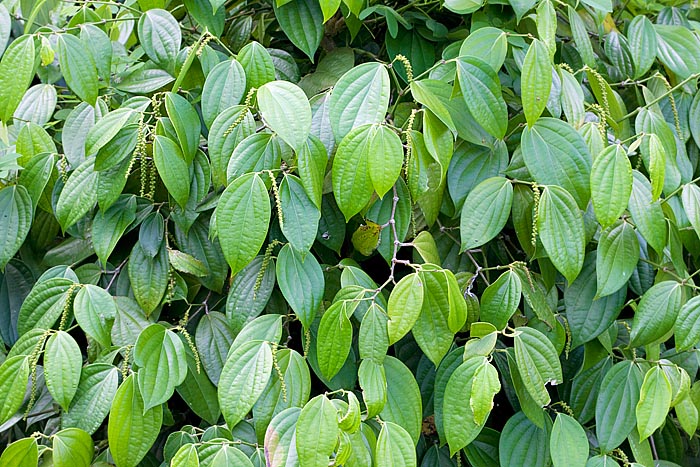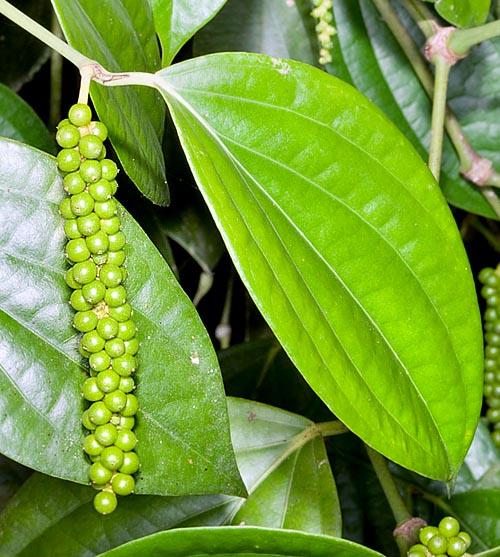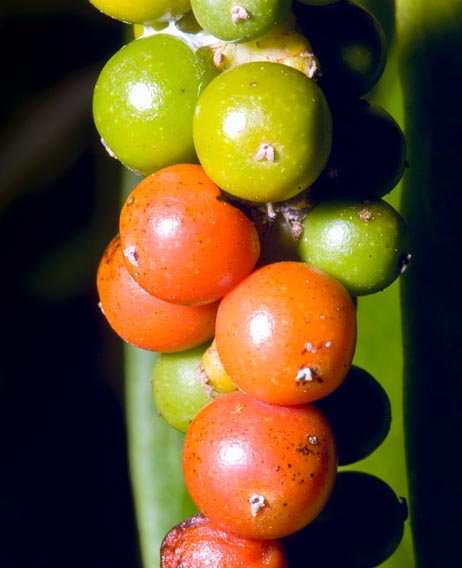Family : Piperaceae

Text © Pietro Puccio

English translation by Mario Beltramini

Piper nigrum is a woody climber with 6-10 m long stems. It makes the world most used spice © Giuseppe Mazza
The name of the genus is the Latin one “piper, -eris” = pepper, of the spice obtained from its fruits; the name of the species is the Latin adjective “niger, -gra, -grum” = brown, black, with reference to the colour of the dried fruits
Common names: black pepper, pepper (English); filfil (Arabic); hu jiao (Chinese); poivre (French); kali mirch (Hindi); pepe (Italian); pimenta, pimenta da India, pimenta do reino (Portuguese); pimienta (Spanish); milagu (Tamil);Pfeffer (German).
The Piper nigrum L. (1753) is a woody, evergreen, climbing species, with knotty stems long up to about 6 m, even if in some cases they can reach the 10 m, which adhere to the support by means of adventitious rootlets produced at the nodes. The leaves, on a 1-4 cm long petiole, are alternate, simple, ovate to ovate oblong with pointed apex, entire margin and prominent nervations, usually of glossy dark green colour on the upper page, paler below, 10-15 cm long and 5-9 cm broad, rather thick and coriaceous.

Black pepper is gotten by drying previously boiled green fruits © Giuseppe Mazza
The pollination in the cultivated plants is favoured by the rain or by the dew which carry the pollen from the upper spikes to the lower ones. The fruit is a globose drupe of 0,4-0,6 cm of diameter, of red colour when ripe, containing only one white seed.
It reproduces by seed, with the first fructification after 7-8 years, through the adventitious basal branches rooting at the nodes, by cutting and grafting, in particular on Piper divaricatum G.Mey (1818), resistant to the nematodes and to the collar rot, the most serious disease affecting the species, caused by Phytophthora sp., which causes serious damages to the cultivations.
Species of significant economic importance, cultivable in the humid tropical climate zones, between the 20° North and South parallels, characterized by high rainfall, well distributed during the year, day temperatures of 25-35 °C and relative humidity over the 70%.
It requires full sun, but the young plants which are to be protected against the excessive summer sun exposition or partial shade and may grow on a vast variety of soils, provided well draining, as it does not stand water stagnations, preferably acidic or neutral, rich of organic substance and kept constantly humid.

They get white pepper from ripe fruits washed for days © Giuseppe Mazza
The spice is commercialized in various forms, depending on the ripening stage and the processes it undergoes; by far the most utilized is the black pepper which is gotten from the completely developed but still green fruits which, after having had a short cooking in warm water are exsiccated in the sun for some days or in appropriate ovens, becoming of blackish brown colour; then comes the white pepper, with a less pungent taste, obtained from the fruits harvested with a greater degree of ripeness, with the colour turning yellow-orange, put in sacks and immersed in running water for some days, operations which softens and detaches the pericarp by friction, and then washed and dried in the sun; it may be also obtained hulling the black pepper by machine. Limited diffusion have the green pepper, obtained by the unripe fruits dehydrated or frozen or preserved in vinegar or brine, and the pink pepper, from the completely ripe red fruits, conserved in brine (not to be mistaken with the berries of the Schinus molle commercialized under the same name). The pepper and its derivatives, besides the well-known utilizations in the culinary practice, do also have applications in the cosmetics industry, in the perfumes one and in the traditional medicine, in particular in the Indian one, where it holds a position of particular importance.
Synonyms: Muldera multinervis Miq. (1846).
→ To appreciate the biodiversity within PIPERACEAE family please click here.
